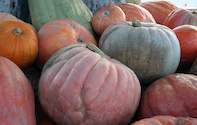
Plant Description
Pumpkin and Hubbard Squash are both squash types or cultivars. The plants can be slightly bush-like or in most cases are a trailing vine that creeps over the ground. Pumpkin and Hubbard squash plants bear both male and female flowers.
Pumpkins can be divided into orange, white or grey skin types. Hubbard’s are numerous but the most popular is the dark green and orange colour varieties. There are large varieties and new small baby varieties that have grown in popularity.
Uses
Pumpkin and Hubbard squash are both used in cooking and are boiled, steamed, roasted or fried. They can be pureed and made into soup, used in pies or made into preserves. These vegetables are a good source of beta-carotene, Vitamin A and Potassium.
The seeds are high in Zinc and can be used in bread, salads or eaten as is. Pumpkins and squash also provide good feed for animals, as at times farmers use part of this crop, that is not suitable for sale, for animal feed.
Soil Requirements and Preparation
A sandy to loam soil is best. Soil must drain well and must have high organic matter content. The pH of the soil should be between 6 and 7. If a green cover crop is to be planted for organic material then this should be done about 12 to 16 weeks before planting, at the time when the past crop residue and weeds are ploughed in.
Disc plough the surface to level after ploughing in crop residue. Sow cover crop seeds and harrow in the seeds directly after this. This is normally done before the winter cold sets in to give the cover crop time to establish itself.
In order to boost the growth of the cover crop, it is advisable to do a nitrogen application of about 150 kilograms of LAN (28) per hectare just after it has established and is about 10 cm high.
At about ten weeks before planting, have the soil analysed. At five to six weeks from planting cut the cover crop and apply nutrients that may be required from the soil test results.
This could be Gypsum, lime for pH or superphosphates. At this time add organic material in the form of manure or composts, if required. Follow this by ploughing the soil down to about 500 mm to mix in all material. One week before planting apply pre-plant fertilizer and disc harrow into top 20 cm of soil and prepare final plant bed for seeds or seedlings.
Climate
Pumpkin and squash do best in warm climates with ideal temperatures between 20°C and 30°C for the growing season. Soil temperatures should be at least 18°C for the best germination of seeds to occur.
As the plant bears both female and male flowers, it is preferable to have a higher percentage of female flowers as this increases the yield. Temperatures of 35°C or higher leading up to and at the time of flower formation, increases the percentage of male flowers formed and reduces yield.
Cultivars
There are well over a hundred different cultivars to choose from. It is best to seek advice from your local seed specialist and extension officer. It is also important to seek advice from your market and consumers. Plant what the market wants.
Some varieties are listed below: Pumpkin: Crown Prince, Flat white Boer, Ford, Jarrahdale, Long Island Cheese, Queensland Blue, Star 7001 and 7022 Hubbard Squash: Green Hubbard, Chicago Warted, Golden Hubbard, Essex Red and Blue Hubbard.
© Louise Brodie